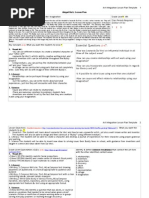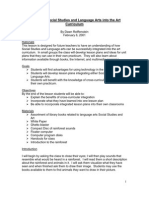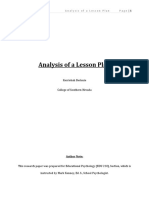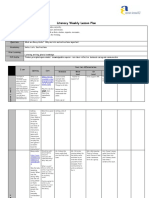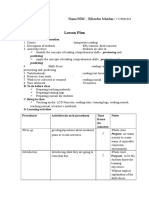Dance Lesson 1
Dance Lesson 1
Uploaded by
api-507303017Copyright:
Available Formats
Dance Lesson 1
Dance Lesson 1
Uploaded by
api-507303017Original Title
Copyright
Available Formats
Share this document
Did you find this document useful?
Is this content inappropriate?
Copyright:
Available Formats
Dance Lesson 1
Dance Lesson 1
Uploaded by
api-507303017Copyright:
Available Formats
(What is a Tropical Rainforest?
Student Teacher Name Date Submitted:
Ms. Smith & Ms. Solimine April 19th, 2019
Contextual/Environmental Factors Implications for Instruction/Content
“Love group games; gravitate to Children at age 8, greatly enjoy group activities.
same-gender activities so the teacher Incorporating working with peers, class
should lead whole-class games” (Wood discussions, and creating movement together can
2007, 102). support students favoritism for group activities.
These activities can bring joy and increase a
student’s participation in each lesson.
“Strong need for routine and closure, Children at this age group can often need
need time to finish their work; appreciate reminders or “heads up” on time. Explaining
a “heads-up” that it’s time to prepare for how much time students have to complete a task
transition” (Wood 2007, 92). or giving reminders on time remaining can allow
students to feel prepared and allow students to
problem solve on how to complete a task in a
given amount of time. It is alsoy important to
have a closure for each activity in order to know
when students are prepared to move on and are
able to adjust their thinking to a new activity.
Smith & Solimine 1
Classrooms at Mason Elementary School Each child will have different physical abilities.
are integrated with students who have Some children may have physical disabilities
disabilities. which can restrict their ability to execute all
movement. The teacher will be able to
accommodate movement for students who have
physical disabilities such as homologous
movement can allow all students to participate in
movement activities.
Mason Elementary School partners with Some of the students may have a background in
Boston Ballet dance, this means that we can adjust the dance
terminology that we use if we notice that
students have an understanding of what we are
teaching. Such as if students already are
progressing with relationship concepts, we can
give them more challenging relationship
concepts to embody.
Size of classroom The size of the classroom can greatly affect
students ability to execute movement. In a
classroom room with little space it may be
needed to move desks or tables in order to create
a space for students to execute movement within
his or her own kinesphere. If there is an open rug
Smith & Solimine 2
in the classroom, this can be a great place for
students to move freely.
Lesson Overview
Lesson Description/Overview
Lesson 1: What is a rainforest?
In this lesson students will be introduced to the ecosystem of tropical rainforests.
The class will have a short discussion about student’s prior knowledge about
tropical rainforest. The class will discuss what plants and animals are found in
a rainforest, where rainforests are found and the climate of a rainforest. The
teacher will present a video to the class that displays the various sounds,
plants, and animals found in a rainforest. The teacher will also post on a large
paper or on the board 5 facts about a rainforest. These facts include
1. Rainforests make up the Earth’s largest life zone.
2. Rainforests have a lot of trees with dense leaves. These trees and leaves can
create canopies that cover the top of a tropical rainforest.
3. The temperature can be very humid.
4. There is a wide variety of animals and plants found in tropical rainforests.
5. Rainforests are found around the equator on Earth.
After this class discussion, students will stand in a circle and explore different
shapes to create various plants and animals found in a rainforest. Students will
be introduced to movement concepts in order to provide students with an
Smith & Solimine 3
outline of material to demonstrate the rainforest concepts. Students will work
with open shapes, closed shapes, angular and curved shapes. Students will
work with non-locomotor and locomotor movement and levels to illustrate
aspects of a rainforest.
Rationale/Purpose
The purpose of this lesson is to introduce students to the ecosystem of tropical rainforests
through somatic and embodied practices. Within this lesson students will become
introduced to movement concepts such as levels in space, non-locomotor and locomotor
movement, and shapes of the body. Students will use these movement concepts to
demonstrate aspects of a tropical rainforest. By using embodied practices students will
have the opportunity to engage in a kinesthetic experience in order to develop an
understanding about a science topic, such as tropical rainforests. This way of learning
can bring new experiences for students by using the body, mind and soul to demonstrate
a concept and visually see these concepts within peer’s movement. This lesson will also
provide students with the opportunity to take any built up energy they have and be
creative with it. Students at this age can often be, “Restless; can’t sit still for long”
(Wood 2007, 112). This lesson will provide students with opportunities to discover their
movement. As students execute movement they are also learning about a tropical
rainforest and ways to improve gross motor skills. The main goal of this lesson is to
provide evidence on how somatic and embodied practices can be used to teach public
school curriculum.
Smith & Solimine 4
Student Learning Outcomes Corresponding Correspondin Assessment
(SLOs) National Core g MA State Methods for
Arts Standard(s) Standard Outcomes
(NCAS)
1. Students will illustrate the 1.DA:Pr4.1.1 1. 1-LS4-1. 1.Formal
Assessment:
animals and plant of a rainforest a. Demonstrate Use texts, With the rubric
attached, the
by using different levels, shapes, locomotor and media, or local
teachers will
and locomotor movement. non-locomotor environments observe students
movement
2. Students will demonstrate to movements that to observe and throughout class
and make notes.
identify his or her own personal change body compare (a) The teacher will
kinesphere. shapes, levels, and different kinds then check off if
students are able
3. Students will demonstrate facings. Move in of living things to illustrate
animals and
open, closed, curved and angular straight, curved, in an area, and plants of a
tropical rainforest
shapes with his or her body. and zig-zagged (b) differences
through using
pathways. Find in the kinds of different
movement
and return to the living things concepts. The
teacher will take
place in space. living in note at students
use of movement
different types
concepts and how
of areas. they imbed each
in the correct
manner.
Critical Essential Question (s)/Focus Questions
1. What types of plants can be found in a tropical rainforest?
Smith & Solimine 5
2. How can we use different levels to illustrate different types of plants or animals?
3. How can we use shapes to illustrate different plants?
4. What does it feel like to do movement on different levels?
Key Concepts/Vocabulary/ Terms
Contextual Factors of a Tropical Rainforest
● Fuana: Monkeys, butterflies, frogs, birds, sloths, snakes, bugs
● Flora: Flowers, Venus flytrap, trees and small shrubs
● Canopy- Overlapping of tree leaves and branches to create an arc over the bottom
of the rainforest (Nelson, 1).
Movement Concepts
● Locomotor movement
● Non locomotor movement
● Low/mid/high level movements
● Open vs. Closed shapes
● Curved shape
● Angular shapes
● Personal Kinesphere
Prerequisite Knowledge/Experience
● Ecosystem
● Movement in low, mid and high level
● Plant
● Animals
Resources
Smith & Solimine 6
Pictures (on paper &/or presented in a slideshow), videos, music, handouts with
definitions, sounds of a rainforest, whiteboard, projector, and hand out or poster with
movements used in class.
Virtual Tour of Tropical Rainforest
https://www.youtube.com/watch?v=8myYyMg1fFE
Sounds of a tropical rainforest:
https://www.youtube.com/watch?v=0zsYOmXmXc8
Poster or handout with pictures of locomotor movement and nonlocomotor
movement
Picture of concepts and definition on board
Closed Shape: The body is facing more in, towards the midline.
Open shape: A person’s heart center is facing out.
Smith & Solimine 7
Angular Shape: This happens when the body uses the joints to make sharp angles,
straight edges.
Curved Shape: When the body makes a circular shape.
Smith & Solimine 8
Picture highlighting where Tropical rainforests are found
Picture of a canopy
Canopy: The top layer of trees. These trees are usually at least 100 feet tall. Their
branches and leaves form an umbrella over the rest of the layers.
Fauna of a Rainforest
Plants in Rainforest:
Venus Fly trap Flower Tall Trees Small Shrubs
Smith & Solimine 9
Fauna of a Rainforest
Frog Monkey Bird Insect (butterfly)
Differentiation
Individual Student(s) Identified Differentiation for Differentiation for
Considered for Lesson Description of Content & Assessment
Content, Teaching Need Pedagogic/Teachin Modifications/
Strategies & g Modifications/ Accommodations
Assessment Accommodations
Modifications/Accomm
odations
1. Student with Students who have For students who Informal
physical physical have a physical Assessment:
disability. disabilities may disability or are Teacher will
have little ability to wheelchair bound, observe students
execute locomotor the differentiation who movement
movement or for content will modification. The
movement that include using teacher will take
requires use of the homologous notes on what
lower body. The movement in movements worked
need for these exercises in order well for students
students is to for these students to and how students
accommodate be able to were able to
movement that the participate in illustrate aspects of
student is able to movement a rainforest.
execute. exercises.
2. Students with verbal Students with For students with Informal
impairments verbal impairments verbal impairments assessment: The
may need an it is important to teachers will take
alternative way to provide these notes about specific
students with students and their
Smith & Solimine 10
communicate in alternative ways to ability to
class activities. communicate. demonstrate
Using dance and movement that
movement can illustrates a tropical
allow students with rainforest. The
verbal impairment teacher will take
to communicate notes about specific
with the body. students who have
Providing students verbal impairments.
with various The teacher will
movements to use also work with IEP
to communicate can teachers in order to
allow students with take thorough notes
verbal impairments on students
to fully progress and
communicate in understanding
lessons. As second about embodying
accomodation that concepts.
can be made, is by
having an IEP
instructor or ASL
instructor to help
translate for
children with verbal
impairments.
3. Students with little Students who have In order to meet the Formal
spacial awareness little spacial needs of students Assessment: With
awareness may who have little a given rubric, the
need specific spacial awareness it teacher will check
instruction on how is important to have off if each student
far his or her body students demonstrates the
can move. Students demonstrate what ability to move
with little spacial his or her own within their own
awareness may kinesphere is and kinesphere.
need a specific how to safely move
place they can within one’s own
stand and move kinesphere.
throughout in order Personalized boxes
Smith & Solimine 11
to fully participate may be given to
in movement students in order for
activities without students with little
hindering or spacial awareness to
affecting other’s have a visual
movement. representation of his
or her kinesphere.
This can be created
by giving students
mats to stand and
move on or taping
boxes on the floor
for students to stand
in.
Lesson Plan
Lesson Plan Description of Content, Pedagogy & Practice Time
(Vary order & repeat or
add transitions &
components as needed)
1. Focus and Review Place mats or boxes for students to stand on in a 7
minutes
circle.
Greet Class
Class will stand in a circle on an open rug or in an
open space.
Explore personal kinesphere
“Today we are going to begin class with a movement
exercise”
“Let’s all reach are arms out to the sides. Now move
your arms in different reach spaces. We are going to
Smith & Solimine 12
outline our personal kinesphere. Throughout class
today we will be moving through a tropical
rainforest. It is important to always be aware of our
kinesphere.
Let’s explore our kinespheres in different levels.
Reach as high as you can. We are moving in the high
level.
How can we move along a mid level?
Explore this
How can we move along the low level
How can we travel around the rug moving in
different levels?
We are now demonstrating locomotor movement
Transition Come to stillness making a tree-like shape standing 1
minute
on the mat.
2. Statement of Present picture of tropical rainforest on board 12 mins
Objective
Warming up; Reviewing Reveal definition below when stated to class.
& Introducing the
“Last class we discussed what habitat is”
concepts
“Can anyone tell me what a habitat is?”
Habitat- A habitat is the home of an animal or a
plant. Most habitats include a community of animals
Smith & Solimine 13
and plants along with water, oxygen, soil or sand,
and rocks.
“Today we are going to be exploring the habitat of
efine tropical rainforest
Tropical Rainforest” D
Tropical Rainforests- Tropical rainforests are located
in the tropics, near the equator. Most rainforests get
at least 75 inches of rain with many getting well over
100 inches in areas.
Engage class in class discussion to gather
prerequisite knowledge about what students know
about Tropical rainforests
“We will be looking at the flora and fauna in a
tropical rainforest”
“What is flora and fauna?”
“Flora a re a particular type of plant species found in
a particular location”
“Fauna are a particular animal species that can be
found or was found in a particular location”
Write definition on the board and present animals
that will be used throughout lesson
● Monkeys
● Butterflies
Smith & Solimine 14
● Frogs,
● Birds
● Insects or Bugs
Watch video of virtual tour of Tropical Rainforest
https://www.youtube.com/watch?v=8myYyMg1fFE
Create poster with facts students can gather about
tropical rainforest. 5 facts to use listed below
1. Rainforests make up the Earth’s largest life
zone.
2. Rainforests have a lot of trees with dense
leaves. These trees and leaves can create
canopies that cover the top of a tropical
rainforest.
3. The temperature can be very humid.
4. There is a wide variety of animals and plants
found in tropical rainforests.
5. Rainforests are found around the equator on
Earth.
(Nelson 2019, 1).
Transition Have students stand in circle to prepare for 1 min
movement.
Smith & Solimine 15
Students will make 1 noise to demonstrate an animal
from the tropical rainforest.
3. Teacher Input “Tropical rainforest are found around the equator.” 15 mins
Directions
Viewing Professional “Where is the equator?”
works, history
Show map of world with highlighted areas showing
tropical rainforest
“Fauna or animals that can be found in a rainforest
onkeys, birds, insects or bugs, frogs, snakes,
are: m
pigs, owls and bats”
“Today we will only focus on monkeys, birds, frogs
and insects”
Post picture of each animal
“Flora or plant species found in a tropical rainforest
include: tall trees, shrubs, flowers and venus fly
traps”
Present pictures of plants and animals in a slideshow
on board
“What colors do we see in a rainforest”
“What sounds do you think we would hear in a
tropical rainforest”
Smith & Solimine 16
4. Guided Practice “For the rest of class we are going to explore how 15 mins
Exploring the concepts
and/or Developing skills we can illustrate a rainforest through movement”
Present pictures of movement concepts on board:
curved shape, angular shape, open/closed shape, and
nonlocomotor/locomotor movement.
“How can we demonstrate a rainforest making
curved shapes; angular shapes; open shapes, closed
shapes.
What animals and plants are in the low level of a
rainforest?
What animals or plants are in the mid level?
What animals and plants are in the high level? What
animals live in the high part of trees?
Transition Create a closed shape in our personal kinesphere and 1 min
stand in stillness.
5. Independent Practice Play sounds of a tropical rainforest: 10
Developing skills and/or minutes
Creating https://www.youtube.com/watch?v=0zsYOmXmXc8
Students will explore improvisational movement by
moving around the designated space exploring
movement concepts. Students will demonstrate
different aspects of the rainforest through their body
and movement.
Smith & Solimine 17
Inquiry based questions to use throughout this part of
the lesson:
What noise can you make to demonstrate different
animals, plant or weather that happens in a tropical
rainforest?
How can you make your movement travel? What
does this movement show?
How can we demonstrate a rainforest making curved
shapes; angular shapes; open shapes, closed shapes?
What animals and plants are in the low level of a
rainforest?
What animals or plants are in the mid level?
What animals and plants are in the high level? What
animals live in the high part of trees?
6. Assessment for With a given rubric, the teacher will walk around the 10 mins
Student Outcomes,
NCAS & MA State room , observe and engage in conversation with
Standards
students during independent practice.
Evaluation
Expressing ideas, The teacher will ask student about their movement
making observations
about one’s own work choices and why they chose these movement
and work of others
concepts to represent certain aspects of the rainforest.
The teacher will fill out the rubric for each student.
Smith & Solimine 18
Transition Teacher will clap 3 times to grab student attention. 1 min
When all students are ready the class will stand in a
circle and get ready for cool down.
7. Closure/Summary Review what was learned in class today. 5 mins
Cooling down
Definitions will be reviewed.
Engage class in a movement cool down
Raise arms and hands to the high level. Explore ways
to demonstrate a rain storm, moving through all 3
levels in space.
End class by standing in circle and create a open
shape.
Thank and dismiss class.
Rubric
Students Name Excelled: Proficient: Developing: Not Used:
Student Student Students Student does not
demonstrates demonstrated demonstrates show ability to
skilled ability to proficient ability some ability to demonstrate
use movement to use movement illustrate movement that
concepts to concepts to concepts, illustrates
demonstrate illustrate although aspects of
aspects of a rainforest. struggles with rainforest
rainforest. using specific
concepts to use
for specific
aspects of the
rainforest.
Smith & Solimine 19
Notes:
Smith & Solimine 20
Bibliography
Rainforest information
2019 Encyclopædia Britannica, Inc. Britannica Kids. Retrieved April 14, 2019.
Megan. “Shape.” Shape, 1 Jan. 1970, lettherebedance.blogspot.com/2015/04/shape.html.
Nelson, Ken. (2019). Science for Kids: Tropical Rainforest Biome. Ducksters.
Retrieved from https://www.ducksters.com/science/ecosystems/rainforest_biome.php
Pictures
Kikkerdirk. “Palm Tree Forest Canopy.” Depositphotos, Depositphotos,
depositphotos.com/7325744/stock-photo-palm-tree-forest-canopy.html.
Orlando School of Dance.” Orlando School of Dance, orlandodance.com/.
“PE Poster: Locomotor Movement.” Teachers Pay Teachers,
www.teacherspayteachers.com/Product/PE-Poster-Locomotor-Movement-1860113.
“PE Poster: Non-Locomotor Movement.” Teachers Pay Teachers,
www.teacherspayteachers.com/Product/PE-Poster-Non-Locomotor-Movement-1860283.
“Rainforest Animals Clipart 4.” WikiClipArt, wikiclipart.com/rainforest-clipart_8400/.
“Tropical Rainforest Plants in Australia.” In Australia,
Tiltson, C. (2016, April 13). Fatsia/Fatsia japonica [Photograph]. 10 tropical plants you can grow
in the UK, HouseBeautiful.com.
“Venus Flytrap Potted Plant.” DudeIWantThat.com,
www.dudeiwantthat.com/household/plants/venus-flytrap-potted-plant.asp.
“Wildlife: We Are All Interconnected.” Rainforest Alliance,
www.rainforest-alliance.org/issues/wildlife.
Smith & Solimine 21
“Year 1 Dance (Shape Work).” Hale Preparatory School,
Rainforest sounds and Rainforest virtual tour
https://www.youtube.com/watch?v=0zsYOmXmXc8
https://www.youtube.com/watch?v=8myYyMg1fFE
Contextual Factors
urner
Wood, Chip. “Nine Year Olds.” In Yardsticks: Children in the Classroom ages 4-14, T
Falls, MA: Northeast Foundation for Children, Inc., 2007
“School Listings / Mason Elementary School.” / Mason Elementary School,
www.bostonpublicschools.org/Page/878.
Smith & Solimine 22
You might also like
- Lbs 405 Music Module Notetaking and Assignment GuideNo ratings yetLbs 405 Music Module Notetaking and Assignment Guide8 pages
- Group Assignment-Feasibility Analysis-Study - 2No ratings yetGroup Assignment-Feasibility Analysis-Study - 26 pages
- Documents - MX A Detailed Lesson Plan in Mapeh IV 2No ratings yetDocuments - MX A Detailed Lesson Plan in Mapeh IV 210 pages
- 7 Strategies For Developing Your Own Curriculum As A New TeacherNo ratings yet7 Strategies For Developing Your Own Curriculum As A New Teacher5 pages
- Integrating Social and Language Arts Into ArtNo ratings yetIntegrating Social and Language Arts Into Art8 pages
- Social Studies - 6 Week Unit: 4th Grade - Texas RevolutionNo ratings yetSocial Studies - 6 Week Unit: 4th Grade - Texas Revolution10 pages
- Work, Play, Art, Craft, Theatre in School CurriculumNo ratings yetWork, Play, Art, Craft, Theatre in School Curriculum15 pages
- Social Studies Final Unit Plan-Pirates of The Caribbean FinalNo ratings yetSocial Studies Final Unit Plan-Pirates of The Caribbean Final13 pages
- Lesson Plan Template: Essential QuestionNo ratings yetLesson Plan Template: Essential Question9 pages
- Final LTC 4240 Art Integration Lesson Plan Template-2No ratings yetFinal LTC 4240 Art Integration Lesson Plan Template-27 pages
- ELD Levels/can Do Descriptors, Etc.) : This Lesson Is Intended For Use in A 9th Grade ELANo ratings yetELD Levels/can Do Descriptors, Etc.) : This Lesson Is Intended For Use in A 9th Grade ELA18 pages
- Choose From The 16 Elements of EMK Appropriate To The Topic.No ratings yetChoose From The 16 Elements of EMK Appropriate To The Topic.4 pages
- The Importance of Developing Reading for Improved Writing Skills in the Literature on Adult Student's LearningFrom EverandThe Importance of Developing Reading for Improved Writing Skills in the Literature on Adult Student's LearningNo ratings yet
- Csoe Lesson Plantemplate For Clinical PracticeNo ratings yetCsoe Lesson Plantemplate For Clinical Practice15 pages
- Theory Through Application: A Study in The Use of Social Media For TeachingNo ratings yetTheory Through Application: A Study in The Use of Social Media For Teaching11 pages
- Argumentative Essay - Extra-Curricular ActivitiesNo ratings yetArgumentative Essay - Extra-Curricular Activities1 page
- PDI NFE Program Progress Report January-June 2009No ratings yetPDI NFE Program Progress Report January-June 200917 pages
- Code of Ethics For Nurses in The PhilippinesNo ratings yetCode of Ethics For Nurses in The Philippines79 pages
- District Monitoring Evaluation AdjustmentNo ratings yetDistrict Monitoring Evaluation Adjustment21 pages
- Lbs 405 Music Module Notetaking and Assignment GuideLbs 405 Music Module Notetaking and Assignment Guide
- Documents - MX A Detailed Lesson Plan in Mapeh IV 2Documents - MX A Detailed Lesson Plan in Mapeh IV 2
- 7 Strategies For Developing Your Own Curriculum As A New Teacher7 Strategies For Developing Your Own Curriculum As A New Teacher
- Social Studies - 6 Week Unit: 4th Grade - Texas RevolutionSocial Studies - 6 Week Unit: 4th Grade - Texas Revolution
- Work, Play, Art, Craft, Theatre in School CurriculumWork, Play, Art, Craft, Theatre in School Curriculum
- Social Studies Final Unit Plan-Pirates of The Caribbean FinalSocial Studies Final Unit Plan-Pirates of The Caribbean Final
- Final LTC 4240 Art Integration Lesson Plan Template-2Final LTC 4240 Art Integration Lesson Plan Template-2
- ELD Levels/can Do Descriptors, Etc.) : This Lesson Is Intended For Use in A 9th Grade ELAELD Levels/can Do Descriptors, Etc.) : This Lesson Is Intended For Use in A 9th Grade ELA
- Choose From The 16 Elements of EMK Appropriate To The Topic.Choose From The 16 Elements of EMK Appropriate To The Topic.
- The Importance of Developing Reading for Improved Writing Skills in the Literature on Adult Student's LearningFrom EverandThe Importance of Developing Reading for Improved Writing Skills in the Literature on Adult Student's Learning
- Theory Through Application: A Study in The Use of Social Media For TeachingTheory Through Application: A Study in The Use of Social Media For Teaching
































